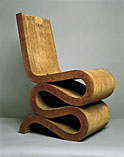|
|
||||||||
|
FURNITURE
DESIGNS 1969–92 Gehry's furniture designs are a "quick fix" of his architectural practice: their realization is relatively immediate and low cost, and they provide a satisfying smaller forum in which various design concerns, including ones relating to his buildings, may be explored. They also demonstrate his fundamental concern with manipulating basic materials in unconventional ways to produce objects that are functional yet also visually striking. For his first designs, Easy Edges (1969–73), Gehry favored the simplicity of corrugated cardboard, a material frequently employed in his architectural models. After discovering that single sheets of cardboard gained exponential strength when layered, he began to manipulate the simple material into graceful, curvilinear chairs and tables. With hardboard facing applied to the flat surfaces, the furniture is immensely durable. Experimental Edges (1979–82) is a bulkier series of cardboard pieces, featuring rough, shaggy edges and an improvisational appearance. Gehry used thick corrugated cardboard with a pronounced texture to create this furniture's larger volumes , manipulating their density by combining sheets of varying widths within a single form. Some sheets were intentionally misaligned within the stacks, creating an undulating line and slight ripples. Gehry's later ventures into furniture design produced the Bent Wood Furniture Collection (1989–92; manufactured 1992– ). The initial bentwood prototypes created for Knoll recall the serpentine lines of the Easy Edges series. Likewise, their structural support and material—partly inspired by the vernacular form of the bushel basket—are seamlessly integrated. A workshop next to Gehry's offices gave him the opportunity to conduct a sustained investigation of maple wood and the production process. Of the 120 prototypes that were developed, four chairs, two tables, and one ottoman were marketed. |
|||||||
